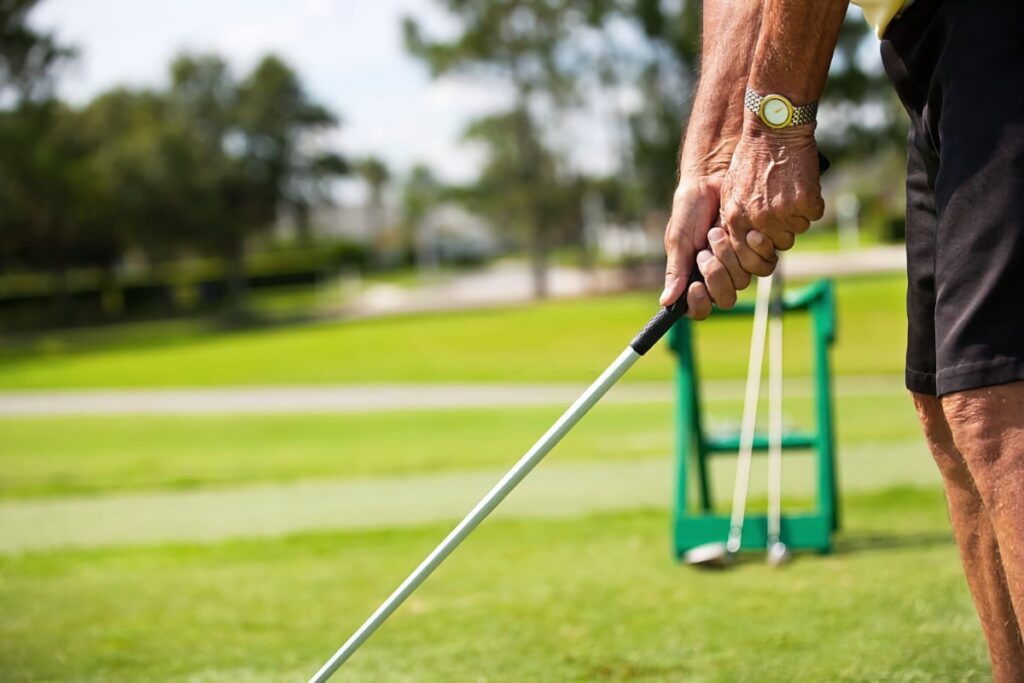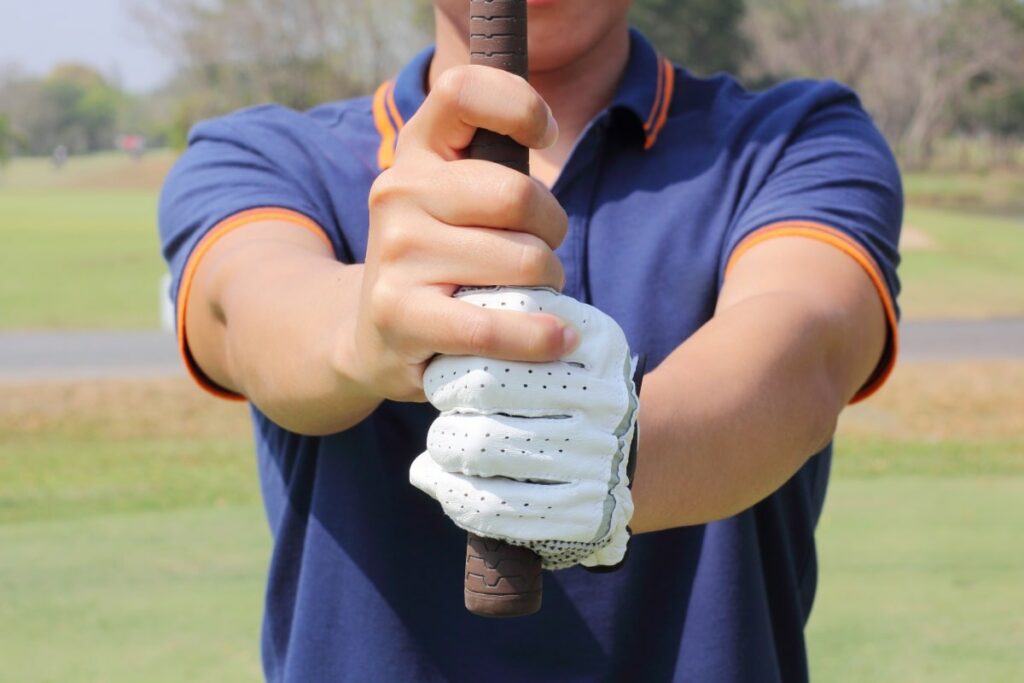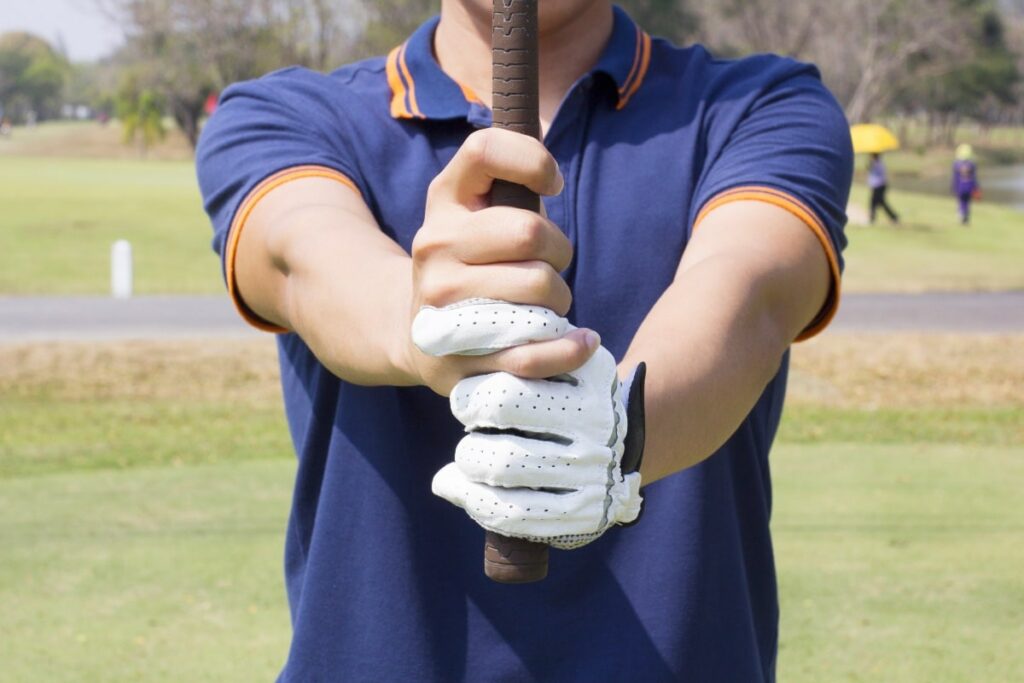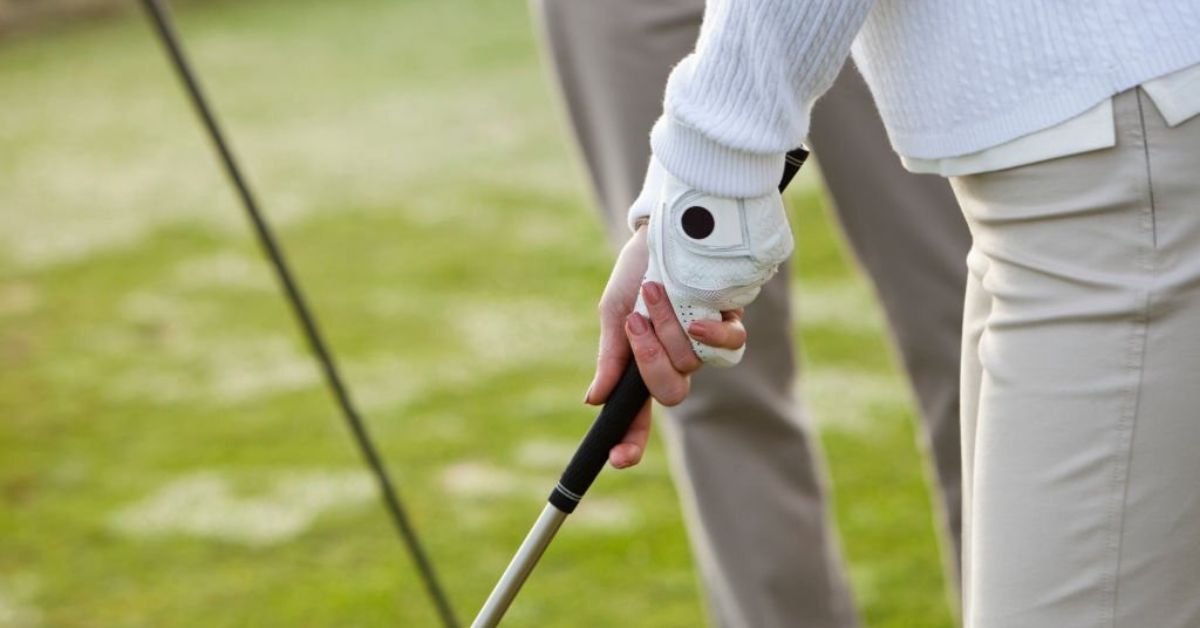When comparing driver grip vs iron grip, there are some subtle but important differences to consider that can have a huge impact on performance.
There are three common grip types: overlapping, interlocking, and ten-finger.
Generally, the grip you choose will remain consistent between clubs. However, players will often make adjustments according to the club in hand.
Many golfers use a neutral iron grip for consistency, then tweak their driver grip to counteract slices or hooks. The longer driver shaft makes it more prone to sidespin, so adjusting to a weak or strong grip helps control the face angle at impact.
Understanding these key differences between driver grip and iron grip can lead to more optimal impact conditions and improved driving accuracy.
Read on to learn more about finding your ideal grip for both driver and irons!
Driver Grip vs Iron Grip
Drivers and irons use the same grip — either overlapping, interlocking, or ten-finger grip based on personal preference. However, the grip can be rotated to be weaker or stronger to counteract slices or hooks. Many golfers make this grip adjustment with the driver while keeping the iron grip neutral.

How to Grip a Golf Club
To begin, it’s important to talk about the standard golf grips used by every player – both amateur and professional. The grip that you choose will be used for every club in your bag, except for the putter grip which is unique in itself.
There are three basic ways to grip a golf club:
- Overlapping grip: Right pinky overlaps left forefinger.
- Interlocking grip: Right pinky interlocks with left forefinger.
- Ten-finger grip: Right pinky adjacent to left forefinger.
Let’s take a look at each grip technique in more detail.
Overlapping Grip
The overlapping grip is the most common golf grip on the pro tour — by some estimates around 90 percent of PGA Tour golfers use the overlapping grip.
By overlapping the right pinky with the left forefinger, both hands work together throughout the golf swing to maintain control of the club.

Interlocking Grip
Another popular grip is the interlocking grip — albeit less common on the professional tour. Interestingly, some of the best golfers in the world use the interlocking grip technique, including Tiger Woods, Jack Nicklaus, and Rory McIlroy.
By interlocking the right pinky with the left forefinger, the hands remain connected throughout the golf swing for better control.

Ten-Finger Grip
Finally, the ten-finger (or baseball) grip is less common and regarded as a beginner grip. Nevertheless, some tour pros such as Jhonattan Vegas and Scott Piercy play with this grip, despite it being very uncommon in high-level golf.
Ultimately, you should try each grip to see which feels most comfortable for you.
The video below explains the differences between each of these grips, so you can decide which grip suits you best.
Driver Grip vs Iron Grip: The Differences
Next, let’s look at the potential differences between the golf driver grip vs the iron grip, specifically the strength of the grip.
Essentially, there are three different grip strengths that measure how the hands sit on the golf club, twisted to the left or to the right:
- Neutral grip: Promotes a square clubface at impact.
- Weak grip: Promotes an open clubface at impact.
- Strong grip: Promotes a closed clubface at impact.
Let’s take a look at each grip style, and how they differ between clubs.
Neutral Grip
A neutral grip is when the hands remain central in the grip. This causes the clubface to be square at impact, resulting in a straighter ball flight.
With a neutral grip, you should see a “V” between your right thumb and forefinger, pointing directly down the center of the shaft.
Many golfers are suited to a neutral grip for their iron swing. This is because it ensures the clubface remains square through impact, encouraging consistency for each iron in the bag.
PRO TIP: A neutral grip is valuable for the iron swing as it helps generate a consistently straight ball flight.
Weak Grip
A weak grip is when the hands are rotated slightly to the left in the grip. This causes the clubface to remain open at impact, resulting in a left-to-right ball flight.
With a weak grip, the “V” will point slightly to the left of the center of the shaft.
Golfers who hook the ball should adopt a weaker grip. This is when the ball curves right to left sharply due to the clubface applying sidespin.
To do this, simply rotate your hands to the left, opening up the club face so that it points slightly to the right at address.
While it’s possible to hook the ball with your irons, it’s more common to hook with the driver due to the longer shaft. This makes it harder to control the clubface angle at impact, so it’s more likely to require some adjustment.
PRO TIP: If you struggle with hooking the driver, consider adopting a weaker grip to open the face more at impact.
Strong Grip
A strong grip is when the hands are rotated slightly to the right in the grip. This causes the clubface to be closed at impact, resulting in a right-to-left ball flight.
With a strong grip, the “V” will point slightly to the right of the center of the shaft.
Golfers who slice the ball should use a stronger grip. This is when the ball curves left to right sharply, as a result of the clubface slicing across the ball at impact.
To do this, rotate your hands to the right, closing up the club face so that it points slightly to the left at address.
Slices with the driver are very common for amateur golfers. This is because the driver head’s center of mass is further back from the shaft than with irons. As a result, the clubface remains more open at impact, causing it to slice across the ball.
Again, it’s possible to slice the ball with irons. However, due to the longer shaft and faster clubhead speed, the sidespin is exaggerated with the driver.
PRO TIP: If you struggle with slicing the driver, consider adopting a stronger grip to close the face more at impact.
The video below demonstrates how each grip style affects the driver swing, helping you understand when to use a weaker or a stronger grip.
Conclusion
In conclusion, there are three basic golf grips that remain the same for both the driver and the iron swing:
- Overlapping grip: Right pinky overlaps left forefinger.
- Interlocking grip: Right pinky interlocks with left forefinger.
- Ten-finger grip: Right pinky adjacent to left forefinger.
However, the position of the hands can change depending on the length of the club, in order to counteract slices or hooks:
- Neutral grip: Promotes a square clubface at impact.
- Weak grip: Promotes an open clubface at impact.
- Strong grip: Promotes a closed clubface at impact.
The driver is most susceptible to slices and hooks, so many golfers choose to adopt a weaker or stronger driver grip while keeping the iron grip fairly neutral.
Ultimately, it’s up to personal preference!
Experiment and see which grip feels most comfortable for both your driver and irons, and make subtle adjustments to counter any pattern of slices or hooks.


